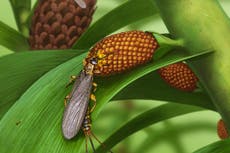Jurassic-era insect found at Arkansas Walmart
‘A finding like this really highlights that even in a run-of-the-mill situation, there are still a tremendous number of discoveries to make about insects’

A professor of entomology has described his amazement after discovering that a bug he discovered at a branch of Walmart in Fayetteville, Arkansas, a decade ago turns out to be a “super-rare” Jurassic-era insect.
Dr Michael Skvarla, director of Penn State University’s Insect Identification Lab, picked up the specimen after it caught his eye outside of the store in 2012. But he did not realise its importance until he discussed it during a Zoom class with students eight years later at the height of the pandemic, whereupon he realised he had mis-identified it.
“I was walking into Walmart to get milk and I saw this huge insect on the side of the building,” Dr Skvarla remembers.
“I thought it looked interesting, so I put it in my hand and did the rest of my shopping with it between my fingers.
“I got home, mounted it, and promptly forgot about it for almost a decade.”
Believing it to be a garden-variety antlion, Dr Skvarla was describing its anatomical structure to his students studying biodiversity and evolution in autumn 2020 when he realised the fly’s wingspan did not match the specifications he was describing.
“We were watching what Dr Skvarla saw under his microscope and he’s talking about the features and then just kinda stops,” recalled Codey Mathis, one of the participating doctoral students.
“We all realised together that the insect was not what it was labelled and was in fact a super-rare giant lacewing.
“I still remember the feeling. It was so gratifying to know that the excitement doesn’t dim, the wonder isn’t lost. Here we were making a true discovery in the middle of an online lab course.”
Dr Skvarla subsequently undertook a molecular DNA analysis of the creature and published his findings in the academic journal Proceedings of the Entomological Society of Washington last November.
Giant lacewings are understood to have been common across North America until the 1950s before they began to disappear from the east of the continent for unclear reasons – increasing light pollution from industrialisation, a diminishing number of wildfires, the emergence of non-native predators or even changes to the soil composition caused by unfamiliar species of earthworms have all been suggested as possible reasons for their eradication.
Dr Skvarla’s Arkansas discovery “represents a new state record and the first specimen recorded in eastern North America in over 50 years”, he declared in his research paper.
“This discovery suggests there may be relictual populations of this large, charismatic insect yet to be discovered.
“It could have been 100 years since it was even in this area – and it’s been years since it’s been spotted anywhere near it. The next closest place that they’ve been found was 1,200 miles away, so very unlikely it would have travelled that far.
“A finding like this really highlights that even in a run-of-the-mill situation, there are still a tremendous number of discoveries to make about insects.”
Join our commenting forum
Join thought-provoking conversations, follow other Independent readers and see their replies
Comments


Bookmark popover
Removed from bookmarks